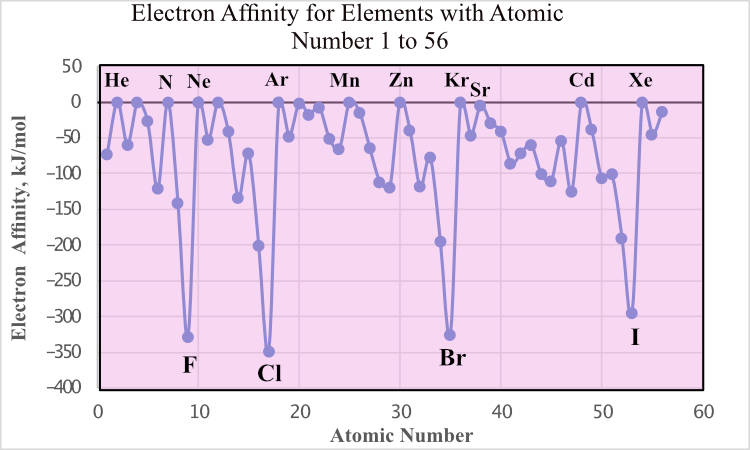The electron affinity, Eea, is the change in energy when an electron is added to an isolated atom in the gaseous phase. We have seen that ionization energies are always positive, but electron affinities are generally negative for many atoms, because energy is released when an electron is added. The more negative the electron affinity, the greater the affinity the atom has for the electron, and the more stable the anion.
In the figure below, electron affinities vs atomic number have been plotted. The halogens, Group 7A, have the most negative electron affinities, while the elements in Group 1A have the least negative values — in fact they are greater than or equal to zero meaning a very small amount of energy is released or energy is absorbed rather than released. The noble gases, Group 8A also have electron affinities equal to or greater than zero meaning either a small amount of energy is released or energy is absorbed when an electron is added.
The alkaline earth metals, Group 2A, have electron affinity values close to zero. This is because they have filled s subshells. An electron would have to be added to a p subshell which is higher in energy. Going down the group, Zeff decreases and it is unlikely an electron will be added to these metals. Generally, with many exceptions, Eea increases as we go across a period due to the increasing Zeff and the fact there is enough room for an electron(s) to be added.
Exercises
Exercise 1. Explain why the electron affinity for nitrogen is zero when compared to C and O.
Exercise 2. Which of the following elements has the least favorable Eea? Which is most favored?
Exercise 3. The electron affinity of Cl is highly negative but the electron affinity of Ar is positive. Explain the difference using electron configurations.
Check Solutions/Answers to Exercises
Back to Periodic Trends and Ionic Compounds
Back to General Chemistry 1 Study Guides
Back to Home Page

